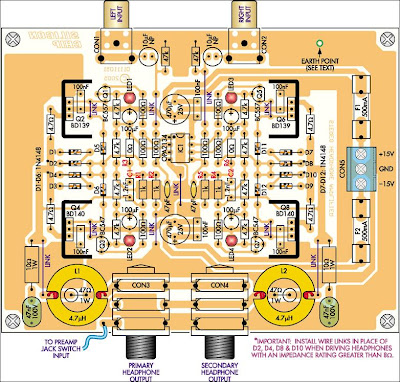Here's a top-class headphone amplifier that can drive high or low impedance 'phones to full power levels, with very low noise and distortion. For best performance, it can be teamed with the Stereo Preamplifier described last month. Alternatively, it can be used as a standalone unit, requiring only a power supply and a volume control pot for use with any line-level signal source (CD/MP3 player etc). It even includes dual outputs, so you can listen with a friend!
Final Result

Many of our high-power audio amplifier designs already provide an output for headphones. The additional circuitry required for headphone support is simple; just two resistors in series with the loudspeaker outputs to limit the drive current and protect the ’phones in the case of amplifier failure.
Considering its simplicity, this resistive limiting scheme works well, although it will cause distortion if the load is non-linear – a likely prospect with most headphones. Apart from eliminating this potential source of distortion, there are a number of other reasons why you might consider building a separate headphone amplifier.
For a start, not everyone owns a pair of top-rated headphones or even a high-performance power amplifier. After all, an amplifier that equals or betters the performance of this new headphone amplifier will set you back more than a few shekels!
Parts Layout

Another reason might be for use with the latest "high-tech" audio electronics gear. The headphone outputs in much of this gear cannot drive low-impedance ’phones – or at least not to decent listening levels. In addition, available output power in portable devices is deliberately limited to conserve battery energy. This means that lots of distortion might be present at higher listening levels, even with sensitive headphones.
One way around this is to feed the line-level outputs of this gear into your power amplifier and then plug your low-impedance headphones into that. That works but then you’re tethered to an immovable object. Besides, the power required to drive headphones is around 1/1000th of that required to drive loudspeakers, so a large power amplifier could be considered a tad oversized for the job!
Circuit Diagram

Features & Performance
Main Features:- High performance – very low noise & distortion
- Drives high and low-impedance headphones
- High output power (up to 200mW; into 8Ω and 32Ω)
- Dual headphone sockets – can drive two pairs!
- Works with a preamp or any line-level audio source
Measured Performance:
- Frequency response : flat from 10Hz to 20kHz (see graphs)
- Rated output power : 200mW into 8Ω and 32Ω, 85mW into 600Ω
- Max. output power (current or voltage limited) : 575mW into 8Ω, 700mW into 32Ω, 130mW into 600Ω
- Harmonic distortion : typically .0005% (600Ω load),.001% (32Ω load) and .005% (8Ω load)
- Signal-to-noise ratio (A-weighted) : -130dB (600Ω), -120dB (32Ω) and -111dB (8Ω) with respect to 100mW output power.
- Channel crosstalk : better than -68dB from 20Hz-20kHz at 100mΩ output power
- Input impedance : ~47kΩ || 47pF
- Output impedance : ~5Ω
Note:
All tests were performed with the amplifier driven from low source impedance. For crosstalk measurements, the non-driven input was back-terminated into 600Ω.
CAUTION!
Continual exposure to very high noise levels (including loud music) will cause hearing loss and can cause tinnitus. Hearing loss is cumulative, gradual and almost symptomless!
Comments
Post a Comment